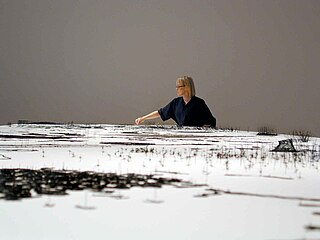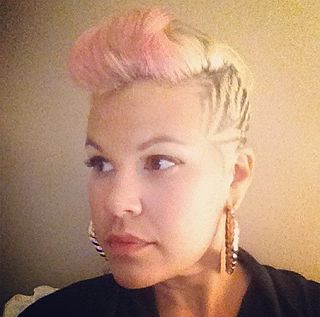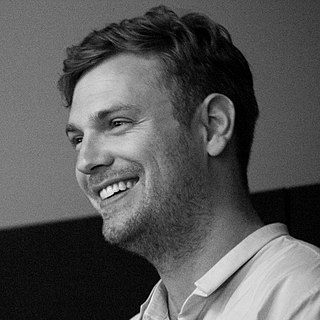Related Research Articles
Elizabeth Joy Peyton is an American contemporary artist working primarily in painting, drawing, and printmaking. Best known for figures from her own life and those beyond it, including close friends, historical personae, and icons of contemporary culture, Peyton's portraits have regularly featured artists, writers, musicians, and actors.

Hannah Wilke was an American painter, sculptor, photographer, video artist and performance artist. Wilke's work is known for exploring issues of feminism, sexuality and femininity.
Kunié Sugiura is a Japanese photographer, painter, and multimedia artist. Her chosen medium is the photogram.

Anne Wilson is a Chicago-based visual artist. Wilson creates sculpture, drawings, Internet projects, photography, performance, and DVD stop motion animations employing table linens, bed sheets, human hair, lace, thread and wire. Her work extends the traditional processes of fiber art to other media. Wilson is a professor in the Department of Fiber and Material Studies at The School of the Art Institute of Chicago.
Ushio Shinohara, nicknamed “Gyū-chan”, is a Japanese contemporary painter, sculptor, and performance artist based in New York City. Best known for his vigorously painted, large-scale and dynamic Boxing Painting series, Shinohara makes use of embodied gestures, appropriation and assemblage, iconographies of mass culture and traditional arts, and vivid tones in his diverse, multidisciplinary practice.

Heather T. Hart is an American visual artist who works in a variety of media including interactive and participatory Installation art, drawing, collage, and painting. She is a co-founder of the Black Lunch Table Project, which includes a Wikipedia initiative focused on addressing diversity representation in the arts on Wikipedia.

Cutie and the Boxer is a 2013 American documentary film produced, shot, and directed by Zachary Heinzerling. The film focuses on the chaotic 40-year marriage of two artists, Noriko Shinohara and her husband the boxing painter Ushio, featuring original artwork by the couple. Heinzerling said of the couple: "When I first met [the Shinoharas], I was just struck by the raw spirit and beauty that emanates from their faces, their lifestyle, their art, everything about them has so much purpose and character. Even if you don’t speak Japanese, even if you have no previous knowledge of their artwork or who they are, you’re immediately captivated by their presence. They live in a world that’s kind of a time warp that hearkens back to the ‘70s New York SoHo art scene that is sort of canonized in history, certainly from my point of view."

Zach Heinzerling is an Academy Award-nominated and Emmy Award-winning director based in New York City. He graduated from the University of Texas in Austin with a degree in Plan II Honors and Philosophy.
Dawn Clements (1958–2018) was an American contemporary artist and educator. She was known for her large scale, panoramic drawings of interiors that were created with many different materials in a collage-style. Her primary mediums were sumi ink and ballpoint pen on small to large scale paper panels. In order to complete a drawing she cut and pasted paper, editing and expanding the composition to achieve the desired scale. Her completed drawings reveal her working process through the wrinkles and folds evident in the paper. She described her work as "a kind of visual diary of what [she] see[s], touch[es], and desire[s]. As I move between the mundane empirical spaces of my apartment and studio, and the glamorous fictions of movies, apparently seamless environments are disturbed through ever-shifting points of view."
Ethan Cohen is an American collector and art dealer based in New York City who specialises in contemporary Chinese art and contemporary African art. He was one of the first western dealers to sell work by contemporary Japanese and Chinese artists including Ushio Shinohara and Ai Weiwei. He has been called "one of the most influential art dealers in the world". Forbes praised his gallery as an "exemplar in the field", putting on "resplendent, probing shows".
Neo-Dada Organizers, often shortened to Neo-Dada (ネオ・ダダ), was a short-lived but influential Japanese Neo-Dadaist art collective formed by Masunobu Yoshimura in 1960. Composed of a small group of young, up-and-coming artists who met periodically at Yoshimura's "White House" atelier in Shinjuku, the Neo-Dada Organizers engaged in all manner of visual and performance artworks, but specialized in producing disturbing, impulsive spectacles, often involving physical destruction of objects, that the art critic Ichirō Hariu deemed "savagely meaningless," and that inspired another art critic, Yoshiaki Tōno, to coin the term "anti-art" (han-geijutsu). Examples included filling galleries with piles of garbage, smashing furniture to the beat of jazz music, and prancing the streets of Tokyo in various states of dress and undress. Using the human body as their medium of art, their violent performances reflected both their dissatisfaction with the restrictive environment of the Japanese art world at the time, as well as contemporary social developments, most notably the massive 1960 Anpo protests against the U.S.-Japan Security Treaty.
Ming Tiampo is a Canadian curator, professor of art history and director of the Institute of Comparative Studies in Literature, Art, and Culture at Carleton University, in Ottawa, Ontario, Canada.
Don Soker Contemporary Art is a San Francisco-based art gallery, established in 1971. It is one of the longest continuously operating contemporary art galleries in the San Francisco Bay Area. The gallery exhibits contemporary international art with an emphasis on conceptual, reductive and minimal work in a variety of media. It was one of the first to show contemporary Japanese art in the 1970s. As of 2017, the gallery is located in San Francisco's Potrero Hill district.
Mildred Beltré Martinez is a Brooklyn-based American multi-disciplinary artist known for activist works that focus on how social justice and grassroots movements might reconfigure society. She is co-founder of the Brooklyn Hi-Art! Machine
Beatrice Scaccia is an Italian visual artist and trained realist painter residing in New York City. Much of her work centers on a protagonist named Eve and other similar genderless characters, with hidden faces, that represent alter egos of the artist. Scaccia's gesso and wax drawings, monotype prints, sketches, paintings, and animations have been exhibited in solo exhibitions in Rome, Milan, and New York City. Her works are also held in the permanent collections of the Farnesina Experimenta at the Palazzo della Farnesina, the Galleria Comunale d'Arte Moderna e Contemporanea in Viareggio, Tuscany, and the William Louis-Dreyfus Foundation.
Sayuri Ushio is a Japanese hairdresser, businesswoman and photographer. She is the inventor of "STEP BONE CUT" technology that is one of the few patent in the world as a haircut technology. She broke Japanese customs that hairdressers are less to target businesses other than visitors to hair salons. She runs a hair salon for 6 shops in Japan and one shop in New York, and she serves as the representative director of the Japan. Small Face Correcting 3D Cut Association that she launched. In addition, she is acting all over the world as a photographer.
Sayako Kishimoto was a Japanese artist who worked across mediums including paintings, drawings, and performances. Best known as one of the few female members in the short-lived art collective Neo-Dada Organizers, Kishimoto investigated female identity and the definition of a female avant-garde artist through destruction-oriented practices in the 1960s. Beginning in the 1970s, Kishimoto's interests shifted toward examining and questioning the political power structure of Japanese society as well as that of the U.S.-Japan relations, and she briefly adopted the style of Pop Art. Later on, she expanded the scope of her artistic inquiry and began to invent a worldview of her own. Kishimoto envisioned a society in which everyone would strive to reach the bottom of a hierarchy instead of the top as in real life. Kishimoto translated her utopian view onto several canvases in the 80s, where motifs of animals and expressive strokes constituted modern allegories. While combatting cancer on the sickbed during the last few years of her life, Kishimoto continued to probe the personal and the political through expressive works on paper as well as performances.
Reiko Tomii is a Japanese-born art historian and curator based in New York. Specializing in Japanese modern and conceptual art in its global context during the postwar period, Tomii is one of the art historians publishing in the English language on postwar Japanese art. Tomii helped organize the first North American retrospective on the work of Yayoi Kusama (1989), and collaborated closely with curator Alexandra Munroe to produce the seminal exhibition and book Japanese Art after 1945: Scream Against the Sky (1994). In 2017, Tomii's book Radicalism in the Wilderness: International Contemporaneity and 1960s Art in Japan was awarded the Robert Motherwell Book Award by the Dedalus Foundation. Tomii is also co-founder and co-director of the postwar Japanese art research collective PoNJA-GenKon.
Masunobu Yoshimura, was a Japanese visual and conceptual artist associated with the Neo-Dada movement. In 1960, he was the founder and leader of the short-lived but influential artistic collective Neo-Dada Organizers, which had as members several young artists who would later become well-known, including Genpei Akasegawa, Shūsaku Arakawa, and Ushio Shinohara. His "White House" atelier in Shinjuku, Tokyo served as the center of the group's activities.
The Yomiuri Indépendant Exhibition, affectionately nicknamed "Yomiuri Anpan," was a famously permissive, unjuried, free-to-exhibit art exhibition held annually in Tokyo, Japan from 1949 to 1963. Sponsored by the Yomiuri Shimbun newspaper, the exhibition was held at the Tokyo Metropolitan Art Museum and played an important role in the emergence of postwar avant-garde and contemporary art in Japan.
References
- ↑ "Shinohara Ushio and Noriko: A Couple Wrestles with the Demon Called Art". nippon.com. 2014-03-02. Retrieved 2018-07-14.
- ↑ "Shinohara, Noriko". www.mutualart.com. Retrieved 2018-07-16.
- ↑ Batko, Ania (2006-09-09). "Ushio Shinohara. Don't Bother My Freedom!". Going. (in Polish). Retrieved 2018-07-16.
- ↑ Shoji, Kaori (2013-12-19). "Japanese couple's canvas alive with the art of love". The Japan Times. Retrieved 2018-07-14.
- ↑ Scott, A. O. (2013-08-15). "'Cutie and the Boxer,' About Ushio and Noriko Shinohara". The New York Times. Retrieved 2018-07-16.
- 1 2 Cassavia, Cayllan. "Noriko Shinohara". guyberube.com. Retrieved 2018-07-14.
- ↑ Pavia, Will (2015-09-12). "The first couple of pop art". The Times. ISSN 0140-0460 . Retrieved 2018-07-16.
- 1 2 Kilgannon, Corey (2013-07-26). "The Art of War". The New York Times. Retrieved 2018-07-16.
- ↑ "Couples Who Art Each Other". Memphis Brooks Museum of Art. Retrieved 2018-07-16.
- 1 2 3 4 5 Carmichael, Emma (August 19, 2013). "Interview with Cutie and The Boxer's Noriko Shinohara". The Hairpin . Archived from the original on January 20, 2018. Retrieved July 16, 2018.
Punish him! Wear like a dominatrix and punish him with 16 inches of dildo.
{{cite web}}: CS1 maint: unfit URL (link) - ↑ ""Noriko Shinohara"" . Retrieved 2021-11-05.
- ↑ "Carleton University Art Gallery Launches Summer Exhibitions". 28 April 2016. Retrieved 2021-11-05.